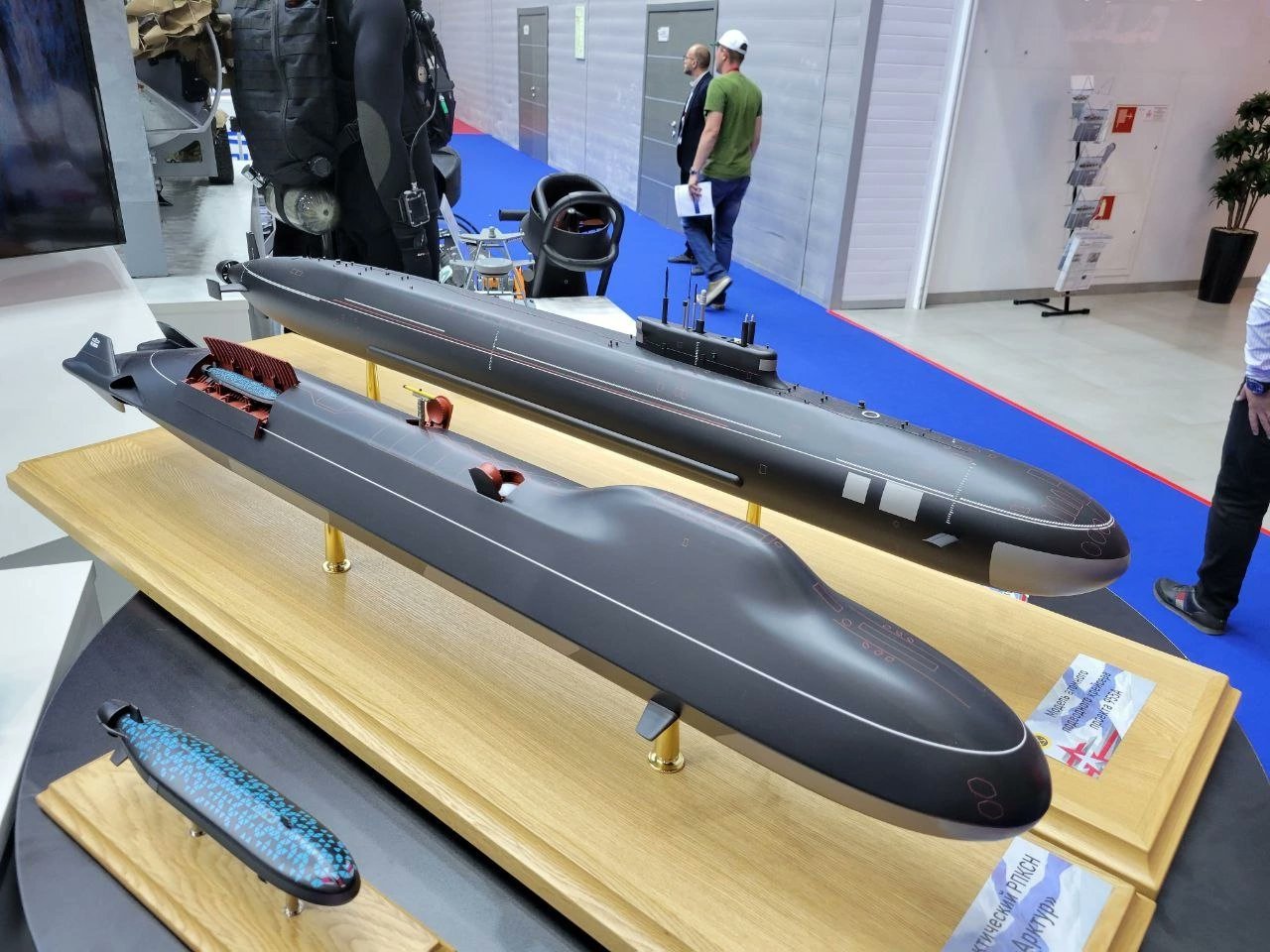The small, sleek, and oddly camouflaged unmanned vessel housed inside the scale model of Russia’s ‘Arktur’ (or Arcturus) stealth submarine, is a wingman that can draw enemy fire and keep the larger submarine safe.
The Rubin Central Design Bureau confirmed this to RIA Novosti on the sidelines of the Army 2022 defense and aerospace exhibition held in Russia.

The Underwater ‘Wingman’
“The Surrogat-V underwater drone can not only lead the enemy on a false trail, imitating the actions of a submarine but also take a hit on itself. It imitates the portrait of a submarine using acoustics, which was presented at the Army-2022 forum. (While) imitating a covered boat, the wingman can lead the enemy on a false trail, perform a diversionary maneuver and, finally, take a hit on itself,” said the Rubin representative.
According to the report, the representative added that the Surrogat-V will be able to serve as a target in naval exercises “so as not to distract from the main tasks of the submarine and reduce the cost of the exercises while maintaining realism and reducing risks.” The Surrogat-V has a displacement of 40 tons and a cruising range of 800 miles, with a “new version of a lithium-ion battery.” It can charge onboard the submarine and on-shore stations at the port and naval bases.
One can infer that the primary submarine acting as a simulated target during exercises or training often saddles it with additional responsibilities, which the Surrogat-V can take on.
However, it is unlikely that the Arktur will never ‘play’ opposing ‘red’ or ‘blue’ force in exercises or wargames since it would prevent the Russian Navy from exploring the full extent of its capabilities and developing diverse tactics.

Naturally, the flexibility and diverse range of options that an onboard drone provides, besides being able to draw enemy fire, will not have been missed by an experienced Navy like Russia’s.
Like airborne wingmen drones that perform surveillance, reconnaissance, electronic warfare, data linking, and weapons release besides kamikaze roles, the Surrogat-V will undoubtedly be linked to the Arktur’s sonar array to enhance its surveillance and detection reach.
“The presence of sonar countermeasures on board the launchers makes it possible to simulate very complex tactical episodes. All these possibilities can also be used in testing new means of detecting submarines and new anti-submarine weapons,” the report added.
It means the Surrogat-V will also detect enemy submarines, acting as an extended sonar detection platform or filling gaps left by the Arktur’s sensors. It helps in significantly reducing the load on the crew, who can focus on other essential aspects of the mission.
Using active sonars is one aspect of tracking enemy submarines that is often fraught with risks. Although successful, it also reveals its location owing to the strength and intensity of the sonar ‘ping’ emission.
Spoofing & Getting Enemy Submarines To Look ‘Elsewhere’
This is where Surrogat-V comes in, where after using “active hydroacoustics,” it would be “difficult” to target and destroy “due to its small size and maneuverability,” the unnamed Rubin official said. In an article in Naval News, submarine and underwater warfare expert HI Sutton notes that Arcturus may carry two to three Surrogate-V AUVs for anti-submarine warfare (ASW).
Surrogate-V has a large conformal array of sonar and pumps jet propulsion for high underwater speeds. However, its defining feature is a non-acoustic “sniffer” system to detect chemical and radiation trails from enemy submarines, called the System Obnarujenia Kilvaternovo Sleda (SOKS).
Rubin officials have described it as a “super heavy autonomous underwater robot,” reiterating its primary role to disguise and conceal the ‘Arktur,’ according to another RIA Novosti report.
Their descriptions not mentioning ASW anywhere highlights Russians are drawing a slight distinction between hunting enemy submarines and protecting the mother vessel. Rubin officials and Sutton note that the Surrogat-V would act as a decoy by replicating “other submarine’s sonar acoustic signatures.”
“The follower will take over the tasks that can unmask the leader – communication, use active search tools,” the Rubin official was quoted. It can be safely assumed that the experience and results from the employment of the Surrogat-V will inspire the development of future unmanned underwater systems and new doctrines as Russia also gears up for a possible naval face-off with North Atlantic Treaty Organization (NATO) members.
Regarding launch and recovery, if done from the flooded chamber/hatch/hangars as shown in the model, the submarine would not have to be at any particular depth, according to retired Indian Navy submariner Commander Ashok Bijalwan. “Speed too might not be an issue as a submarine can ‘trim’ its speed any time it requires,” Bijalwan added.
- The author can be reached at satamp@gmail.com
- Follow EurAsian Times on Google News




